Standard temperature in public buildings. Air humidity: norms in different rooms and the value of normal indicators
Drawing up standards and monitoring their implementation - this responsibility is assigned to SanPiN. First of all, the activities of organizations that carry out the design and construction of buildings, as well as institutions involved in the maintenance of existing housing stock, are regulated. The following norms include residential buildings and apartments in which people live permanently. That is, they do not apply to schools, summer cottages, gyms and other structures.
Temperature standards in the apartment during the heating season
The GOST 30494-2011 section contains a list of requirements for heating in residential buildings: temperature conditions for each group of premises, system installation rules. What is the air temperature in the apartment? - it depends on the season:
- Outside the heating season, the temperature is not standardized; in the heating season, in accordance with the standards, the thermometer should not go below 18 degrees.
- Separately, the temperature norm for corner apartments(not lower than 20 degrees).
- The maximum temperature of the heating surfaces of radiators and pipes is 90 degrees, there must be protective screens.
- For each group of premises, the requirements are specified in the SanPiN table. In case of non-compliance with the standards, apartment residents may make claims to the organization responsible for this.
Table 1. Temperature norm in the apartment during the heating season (in accordance with GOST)
| Period of the year | The name of a room | Air temperature, °С | |
|---|---|---|---|
| optimal | admissible | ||
| Cold | Living room | 20-22 | 18-24 |
| Living room in areas with the temperature of the coldest five-day period (security 0.92) minus 31 ° C and below | 21-23 | 20-24 | |
| Kitchen | 19-21 | 18-26 | |
| Toilet | 19-21 | 18-26 | |
| Bathroom, combined bathroom | 24-26 | 18-26 | |
| Premises for rest and study | 20-22 | 18-24 | |
| Inter-apartment corridor | 18-20 | 16-22 | |
| lobby, stairwell | 16-18 | 14-20 | |
| Storerooms | 16-18 | 12-22 | |
| Warm | Living room | 22-25 | 20-28 |
The norm of humidity in the room
The level of humidity in the living room regulated by section GOST 30494-96, the indicator is indicated as a percentage. There are two main values: optimal and acceptable. Optimal is the creation of an ideal microclimate for a person. Permissible - departing from the ideal, but not harmful to health.
Strict standards are provided only for bedrooms, living rooms, children's rooms, where a person works and rests.
- The optimal value of the relative humidity of the air is 30-45%,:
- Permissible rate air humidity in the above residential premises - up to 60%.
For utility rooms (bathrooms, corridors, hallways, kitchens), the humidity level is not standardized.
Important! The norm of air humidity in the apartment in winter and summer is identical.
Hot water temperature standards
Hot water temperature standards are registered in the GOST 2874-82 section. After heating, the lower limit should be 60 degrees (at this temperature, most pathogens die). The maximum figure is 75 degrees, in order to avoid injury. For closed heating systems, a lower temperature of 50 degrees is permissible. Hot water higher temperature is supplied only to certain enterprises and is additionally heated.
Noise level standards in the apartment
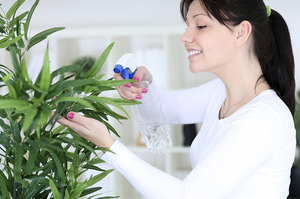
According to GOST 12.1.036-81, the limits of the permissible level of external stimuli are established. Noise level It is measured in decibels and for each time of day it is different:
- Daytime (from 7 am to 11 pm) maximum level noise should not exceed 55 dB.
- At night (and at this time of day the hearing organs are more sensitive to stimuli) - 45 dB.
We would like to remind you that the one who makes the claim. For adjacent territories, the noise norm during the day is 75 dB, at night - 60 dB.
Lighting standards in the apartment
All of the following lighting standards are generally accepted in accordance with SNiP 23-05-85. Illumination is measured in lux (Lx). As a rule, it is indicated when measuring from the floor.
Table 2. Lighting standards in residential premises

Vibration level standards
The norms for the level of vibration in the room are prescribed in the section SNiP P-12-77 and GOST 12.1.036-81. This is especially true for residents whose homes are located near railway stations, subways, large enterprises and other sources of vibration. Let us explain that category A - increased comfort, B - normal conditions, C - allowable conditions. Vibration measurements should be carried out by specialists.
Table 3. Vibration rate according to GOST
| Name of premises | Sound pressure levels, dB, in octave frequency bands with geometric mean frequencies, Hz | Sound levels and equivalent sound levels, dBA | |||||||
|---|---|---|---|---|---|---|---|---|---|
| 63 | 125 | 250 | 500 | 1000 | 2000 | 4000 | 8000 | ||
| Living rooms of apartments, bedrooms of rest houses and boarding houses, children's preschool institutions and boarding schools: | |||||||||
| afternoon | 63 | 52 | 45 | 39 | 35 | 32 | 30 | 28 | 40 |
| at night | 55 | 44 | 35 | 29 | 25 | 22 | 20 | 18 | 30 |
| Rooms in hotels and living rooms in hostels: | |||||||||
| afternoon | 67 | 57 | 49 | 44 | 40 | 37 | 35 | 33 | 45 |
| at night | 59 | 48 | 40 | 34 | 30 | 27 | 25 | 23 | 35 |
| Halls of hotels, hostels and recreation facilities , afternoon | 71 | 61 | 54 | 49 | 45 | 42 | 40 | 38 | 50 |
| Halls of cafes, restaurants, canteens , afternoon | 75 | 66 | 59 | 54 | 50 | 47 | 45 | 43 | 55 |
| Trading floors and waiting rooms of trade and consumer services enterprises, railway stations , afternoon | 79 | 70 | 63 | 58 | 55 | 52 | 50 | 49 | 60 |
For violation of the norms of SanPiN, a fine follows. Individuals oblige to pay up to 1,000 rubles, legal - up to 20,000 rubles. All areas of construction and operation are prescribed in the SanPiN norms, violation of each of them lowers the quality of life and may lead to poor health, so be vigilant!
The microclimate of educational and other premises, which, according to the Interstate standard GOST 30494-2011 “Residential and public buildings. Indoor microclimate parameters” is characterized by the following parameters: 1 – air temperature; 2 – air velocity; 3 – relative air humidity; 4 - resulting room temperature; 5 - local asymmetry of the resulting temperature.
In GOST 30494-2011 “Residential and public buildings. Indoor microclimate parameters” provides the following definitions.
1. Permissible microclimate parameters: Combinations of values of microclimate indicators, which, with prolonged and systematic exposure to a person, can cause a general and local feeling of discomfort, deterioration of well-being and a decrease in efficiency with increased stress on thermoregulation mechanisms and do not cause damage or deterioration in health.
2. Air quality: The composition of the air in the room, in which, with prolonged exposure to a person, the optimal or acceptable state of the human body is ensured.
3. Optimal air quality: The composition of the air in the room, in which, with prolonged and systematic exposure to a person, a comfortable (optimal) state of the human body is ensured.
4. Permissible air quality: The composition of the air in the room, in which, with prolonged and systematic exposure to a person, an acceptable state of the human body is ensured.
5. Local asymmetry of the resulting temperature: The difference in the resulting temperatures at the point of the room, determined by a ball thermometer for two opposite directions.
6. Room microclimate: The state of the internal environment of the room, which has an impact on a person, characterized by indicators of air temperature and enclosing structures, humidity and air mobility.
7. Served area of the premises (habitat area): The space in the room, limited by planes parallel to the floor and walls: at a height of 0.1 and 2.0 m above the floor - for people standing or moving, at a height of 1.5 m above the floor - for sitting people (but not closer than 1 m from the ceiling with ceiling heating), and at a distance of 0.5 m from internal surfaces outdoor and internal walls, windows and heaters.
8. Optimal microclimate parameters: The combination of values of microclimate indicators, which, with prolonged and systematic exposure to a person, provide a normal thermal state of the body with minimal stress on thermoregulation mechanisms and a feeling of comfort for at least 80% of people in the room.
9. Premises with permanent residence of people: A room in which people are at least 2 hours continuously or 6 hours in total during the day.
10. Radiation room temperature: The temperature averaged over the area of the internal surfaces of the enclosures of the room and heating devices.
11. Resulting room temperature: A complex indicator of the radiation temperature of the room and the air temperature of the room, determined according to Appendix A of GOST 30494-2011 “Residential and public buildings. Indoor microclimate parameters".
12. Air speed: Air velocity averaged over the volume of the serviced area.
13. Ball thermometer temperature: The temperature at the center of a thin-walled hollow sphere, which characterizes the combined effect of air temperature, radiation temperature, and air velocity.
14. Warm period of the year: A period of the year characterized by an average daily outdoor temperature above 8 °C.
15. Cold period of the year: A period of the year characterized by an average daily outdoor temperature of 8 °C or lower.
The meteorological conditions of the working environment (microclimate) affect the heat exchange process and the nature of the work. Prolonged exposure of a person to unfavorable meteorological conditions sharply worsens health, reduces labor productivity and leads to diseases. When normalizing meteorological conditions in the premises, the time of year and the physical severity of the work performed are taken into account. The time of year means two periods: cold (the average daily temperature of the outside air is +8 ºС and below) and warm (the corresponding value exceeds +8 ºС). To create favorable working conditions that meet physiological needs human body, sanitary standards establish the optimal and permissible meteorological conditions in the room.
Optimal microclimatic conditions are a combination of quantitative indicators of the microclimate, which, with prolonged and systematic exposure to a person, ensure the preservation of the normal thermal state of his body without straining the mechanisms of thermoregulation. They provide a sense of thermal comfort and create the prerequisites for a high level of performance. Permissible microclimatic conditions are a combination of quantitative indicators of the microclimate, which, with prolonged and systematic exposure to a person, can cause transient and quickly normalizing changes. thermal state of his organism, accompanied by the tension of the body of thermoregulation, not going beyond the limits of physiological adaptive capabilities. In this case, there is no deterioration or impairment of health, but uncomfortable heat sensations, deterioration in well-being and a decrease in working capacity may occur.
Part atmospheric air includes nitrogen (78.08%), oxygen (20.95%), carbon dioxide (0.03%), argon and other gases (0.94%). Oxygen is essential for human life. When breathing, the venous blood entering the lungs is freed from carbon dioxide and enriched with oxygen. In the process of moving through the body, the blood gives oxygen to the tissues and takes away the carbon dioxide formed in them. Gas exchange occurs normally at pressures close to atmospheric. Nitrogen is a physiologically harmless gas. Carbon dioxide slightly toxic, but dangerous because, by replacing oxygen, it reduces its content in the air. The composition of the air, in addition, includes water vapor, dust and other impurities. Small deviations in the content of these gases and, first of all, a decrease in the concentration of oxygen and an increase in the content of carbon dioxide reduce efficiency, and with significant deviations from the norm, the atmosphere becomes dangerous for human life.
A significant impact on the human body is exerted by changes in atmospheric pressure in the direction of increasing or decreasing. Influence high blood pressure associated with the mechanical (compression) and physico-chemical action of the gaseous medium.
Optimal diffusion of oxygen into the blood from the gas mixture in the lungs occurs when atmospheric pressure about 760 mmHg Art. The penetrating effect at elevated atmospheric pressure can lead to the toxic effect of oxygen and indifferent gases, an increase in the content of which in the blood can cause a narcotic reaction. With an increase in the partial pressure of oxygen in the lungs by more than 0.8–1.0 atm, its toxic effect is manifested - lung tissue damage, convulsions, collapse. Lowering the pressure has an even stronger effect on the body. A significant decrease in the partial pressure of oxygen in the inhaled air, and then in the alveolar air, blood and tissues of a person after a few seconds leads to loss of consciousness, and after 4-5 minutes to death. A gradual increase in oxygen deficiency causes a breakdown in the functions of vital organs, then to irreversible structural changes and death.
The well-being of a person is highly dependent on the temperature regime. A negative impact on the human body is exerted by both an increase and a decrease in the air temperature in the premises compared to their standard values for the respective premises.
According to the Sanitary and Epidemiological Rules and Regulations SanPiN 2.4.2.2821-10 "Sanitary and Epidemiological Requirements for the Conditions and Organization of Education in General Educational Institutions", the air temperature, depending on climatic conditions, in classrooms and offices, psychologist's and speech therapist's offices, laboratories, assembly hall, canteen, recreation, library, lobby, wardrobe should be 18–24 °C; in the gym and rooms for sectional classes, workshops - 17–20 ° С; bedroom, playrooms, premises of preschool education units and school boarding school - 20–24 ° С; medical offices, locker rooms of the gym - 20–22 ° С; showers - 25 °C.
When the ambient temperature rises compared to the norm, especially by a significant amount, a person quickly gets tired, his ability to work decreases, the body relaxes, sweating increases, and even “heat stroke” and other serious negative health consequences become possible. Therefore, it is necessary to teach each student effective and economical methods of lowering the air temperature in each room to the standard value during the warm season (when excess heat enters the premises from environment) and during the cold period of the year (when in some rooms the temperature may be higher than the norm due to misalignment of heating systems and the so-called "overheating", and the opening of the windows, typical for such cases, sharply reduces the relative humidity of the air in the premises and has a harmful effect on the human body if the air in the room is not humidified).
The decrease in indoor air temperature compared to
normative values during the cold period of the year, worsening working conditions in them and causing damage to human health, occurs during the operation of all even properly designed and installed central water heating systems, since in accordance with the current regulatory documents they are designed with a security factor K about \u003d 0, 92. That is, all projects provide that 8% of the time of the duration of the heating period, the temperature in all rooms should be below the standard value.
For example, in the city of Tula, all systems of central water heating of buildings are designed so that at least 16 days in the coldest period of the year, equal to 207 days at K vol \u003d 0.92, they cannot heat indoor air to standard temperatures at design parameters and costs coolant, and due to shortcomings in their installation and long-term operation of systems (due to the formation of scale in heaters and pipes, hydraulic misalignment, etc.) - even longer. Therefore, when doing work, students should study and learn how to apply the best world achievements in order to improve the microclimate in the premises at any time and with a minimum of the necessary funds and labor for this, which is important for a real improvement in their working conditions at any job.
The radiation temperature of the room, the resulting room temperature and the local asymmetry of the resulting temperature have become indicators of the microclimate because at the same air temperature in the room, the heat sensation of a person due to radiant heat exchange can be different, especially near windows.
In addition to air temperature the most important indicator is the radiation temperature, which is confirmed by the regulations in force in many countries. In these regulations, one of the main input data are the values of the so-called resulting temperature, calculated using various formulas. The effect of radiation temperature on human heat perception has been studied by many scientists, some of whom also studied the role of radiation temperature in determining the degree of negative and positive radiation, which characterizes the difference in radiation-convective temperature, and the possibility of reducing this difference in warm and cold periods of the year due to the correct placement of plants on window sills.
Resulting room temperature(room temperature) is the ambient temperature in which a person gives off the same amount of heat through radiation and convection as in an environment with the same air temperature and surrounding surfaces at the same humidity and air speed.
Thermal radiation is the process of converting heat into radiant energy and transferring it to the surrounding space. When all bodies are heated, part of the heat is inevitably converted into radiant energy as a result of atomic perturbations. The carriers of radiant energy are electromagnetic waves. The resulting heat flux from the radiating medium with absolute temperature T env to the surface, the average absolute temperature of which is equal to T s, is determined by formula (1), based on the Stefan-Boltzmann law:
W / m 2, (1)
where σ0 - emissivity, W / (m 2 K 4); ε pr - reduced degree of emissivity, depends on the properties of the radiating medium and surface and is expressed in fractions of the degree of emissivity of an absolutely black body, equal to 1.
In formula (1), the values of absolute temperatures are included in the fourth degree, therefore, even with small temperature differences on the surfaces of bodies emitting electromagnetic waves, the values of heat fluxes are significant. Because of this and the rising cost of energy resources, it is necessary to be able to improve the microclimate and labor protection in the premises and energy saving, reducing the radiant heat flux, primarily through the glazing of windows (during the warm and cold periods of the year).
The humidity of the air also affects the well-being of a person. high relative humidity(the ratio of the content of water vapor in 1 m 3 of air to their maximum possible content in the same volume) at high air temperatures contributes to overheating of the body, at low temperatures it enhances heat transfer from the skin surface, which leads to hypothermia of the body.
Low humidity causes the mucous membranes of the human respiratory tract to dry out. By sanitary standards allowable relative humidity (percentage of moisture from the maximum possible value at a given temperature) in classrooms should be 40-60%, in the warm season it can be increased to 75%.
When the relative humidity of the air drops below these values, dry air "draws" moisture from the human body, from wooden things and plants. As a result, even in healthy people, general well-being worsens (drowsiness, absent-mindedness appear, fatigue increases, efficiency and immunity decrease). Due to the fact that the dry mucous membranes of the respiratory organs do not catch bacteria and viruses well, a sore throat occurs, and the ability of the bronchi to self-cleanse is reduced. As a result, the likelihood of respiratory infections increases, the well-being of patients with bronchial asthma and allergy sufferers worsens. There is also a feeling of "sand" in the eyes, especially noticeable in those who wear contact lenses. In dry air, you can freeze faster, because the moisture evaporating from the surface of the skin cools the body. The lack of moisture in the air leads to dryness and early aging of the skin.
Particularly affected by dry air are small and infants, who in the first months and years of life have very delicate and sensitive skin and mucous membranes of the mouth and nose. Therefore, pediatricians recommend that the relative humidity in the baby's room be at least 50%.
The lack of moisture in the air adversely affects paintings, musical instruments, wooden furniture, parquet floors (they do not dry out, crack and their service life is greatly reduced). Dry air also contributes to the accumulation of static electricity and prevents the settling of room dust, which literally hangs in it and can be very difficult to remove. Houseplants and pets also suffer from insufficient air humidity.
Humidity is especially low indoors in winter. Frosty air contains little moisture and therefore airing the room reduces the humidity in it. The operation of heating systems dries the air even more. In winter, the relative humidity in rooms often drops below 25%, since when airing rooms in winter, lighter warm air comes out of the room through the upper part of any window due to the density difference. wet air, and through the lower part of the window, a heavier and dry cold outdoor air, in which there is much less moisture.
Therefore, due to the dryness of indoor air in winter time, as shown by foreign researchers, people in such rooms develop chronic diseases of the upper respiratory tract. And if, as a result of metabolic processes, the skin of the body loses approximately 0.5 liters of moisture during the day, then in winter this figure reaches one liter. In summer, the air in the room becomes drier due to the running air conditioners. Working electric stoves, irons, TVs, computers also dry the air in the apartment, as they heat it up.
To eliminate all these unpleasant phenomena, it is necessary, especially in the autumn-winter period, to humidify the air in the room, that is, to saturate it with water vapor. Previously, for these purposes, housewives put pallets of water on central heating radiators or hung wet linen in rooms to dry. But these methods are ineffective and unhygienic. Therefore, at present, many different humidifiers are produced and sold in the world - devices that allow you to maintain the required level of humidity in the room.
It is important for the well-being of a person the movement of the surrounding air. It effectively contributes to the heat transfer of the human body and is positively manifested in high temperatures, but negatively at low values. Before the start of classes and after their end, it is necessary to carry out cross-ventilation classrooms by opening windows and doors. Airing of educational premises during breaks, and recreational ones during lessons is carried out by opening vents and transoms, the area of which should be at least 1/50 of the floor area. Window vents and transoms must function at any time of the year, it is forbidden to hammer them with nails and glue them.
Average speeds of air movement in industrial and educational institutions should be 0.2–0.5 m/s in the cold and transitional seasons and 0.5–1.5 m/s in the warm season. A person begins to feel air currents from an air speed of 0.15 m / s.
The above parameters are given for working area, which is understood as a space up to 2 meters above the floor level or a platform on which there are places for permanent or temporary stay of a person, and are considered acceptable for educational premises of educational institutions.
One of the main characteristics of a healthy indoor climate is air humidity. A normal level of humidity is very important for a person's well-being. Therefore, it is necessary to know what the normal humidity indicator should be in order to control it and, if necessary, increase or decrease.
Air humidity norm
To assess the microclimate various premises used relative humidity, measured as a percentage. That is, the ratio of the amount of water vapor in the air to a given ambient temperature is determined.
For good health, the optimal humidity level is between thirty and forty-five percent. The allowable rate for residential premises is no more than sixty percent. Such humidity is considered comfortable not only for humans, but also for birds, animals and even household appliances and furniture.
According to state building codes in residential premises, the humidity indicator should be:
- from 30 to 45% in the cold season;
- from 30 to 60% in the warm season.
The humidity rate also depends on the value of the room:
- in the bathroom and in the kitchen, it should be from 40 to 60%;
- in the living room and dining room - from 40 to 60%;
- in the library and office - from 30 to 40%;
- in the children's room - from 45 to 60%;
- in the bedroom - from 40 to 50%.
In winter, the air in the apartments dried up heating systems and air conditioning in the summer. Along with this, the amount of dust increases, and pathogenic microbes appear that contribute to a decrease in immunity and cause viral diseases.
If there are no air conditioners in the room, then in autumn and summer, at temperatures up to thirty degrees and frequent ventilation, the humidity index of the air in houses and apartments is most often normal.
The value of normal air humidity
 A normal indoor humidity helps maintain immunity and human health, as well as keep furniture, things and a beautiful view in good condition. indoor plants. However, it is not easy to keep the indicators in the norm. In most houses and apartments, the humidity is lowered for the main part of the year.
A normal indoor humidity helps maintain immunity and human health, as well as keep furniture, things and a beautiful view in good condition. indoor plants. However, it is not easy to keep the indicators in the norm. In most houses and apartments, the humidity is lowered for the main part of the year.
If the level is below normal:
- The nasal mucosa dries up.
- The process of breathing worsens, as a result of which the body is little enriched with oxygen.
- The risk of viral diseases increases.
- Often there is a feeling of drowsiness.
- Decreased performance.
- The mucous membrane of the eyes dries up in those who wear contact lenses.
- Due to the increased dust content in the room, allergic reactions can occur.
Children especially suffer from low air humidity in an apartment or house.
Increased moisture content indoors promotes the formation of fungus and mold, the occurrence of respiratory diseases, reduced immunity, reproduction of dust mites.
In order for the humidity in the apartment to be optimal, it is recommended to monitor its indicators and, if necessary, increase or decrease it.
How to check the humidity in the apartment
To do this, you can use a special device or improvised means.
Humidity instruments
The percentage of water vapor in the air can be found using a psychrometer, hygrometer, or a special household indicator.
More accurate instruments are psychrometers which may be electrical or mechanical.
Hygrometers exist:
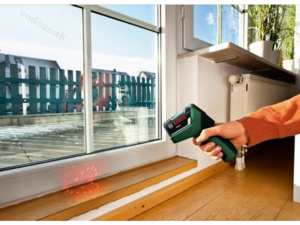
Each type of device has its own characteristics, but one base of measurement. Using a hygrometer is very simple - it shows the percentage of the amount of moisture in the room.
Today you can buy domestic weather stations, which are digital thermometers equipped with humidity indicators. With the help of such a device, you can find out not only the humidity in the room, but also the ambient temperature, as well as upcoming changes in nature.
Folk remedies
If there is no special device for this device at hand, then you can use improvised means.
For example, you can use a glass of water, which will need to be cooled in the refrigerator for five hours. After that, the glass is pulled out and placed on the table away from the radiators:
- If after five minutes a glass of water remains misted, then the microclimate in the apartment is normal.
- If trickles flow down it, then the humidity is increased.
- If the glass has time to dry in five minutes, then this indicator is lowered.
You can estimate the humidity level in a room using tables Assmann and thermometer. To do this, having fixed the temperature that the thermometer shows, it will need to be wrapped in a wet cloth and wait five minutes. After that, the tissue is removed, and the result obtained on the thermometer is recorded.
In the Assmann table, the dry thermometer readings are shown vertically, and the difference between the two indicators is shown horizontally. At the intersection will be the humidity indicator of the room.
You can build a "hygrometer" yourself, taking for this spruce bump and fixing it with tape or a carnation on plywood. Then you will need to watch her:
- if the cone remains unchanged for a long time, then the humidity in the room is normal;
- if her scales quickly begin to open, then the indicator is lowered;
- if even after a day the tips of the scales do not rise at least a little up, then the humidity in the apartment is high.
You can determine the moisture content by indoor flowers. From them it is easy to find out that the air in the room is dry. If in Fatsia, Asplenium, Diefenbachia, Dracaena, Ficus, the tips of the leaves dry up and even spraying does not help, then there is low humidity in the house or apartment.
You also need to listen to your feelings. At an extremely low rate, irritation and constant dryness in the throat and nose may occur.
For comfortable microclimate in the apartment you need:
- regularly do wet cleaning;
- ventilate the room;
- grow indoor plants.
If the humidity level is low
Most often in the winter season in the apartment humidity index lowered. To normalize it, you need to take measures:
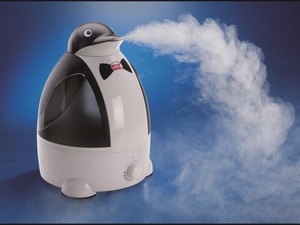
But the most modern way to increase the moisture in the air is a special humidifier, into which water is poured, which evaporates during operation of the device.
Traditional Humidifier equipped with a fan that drives air through the water tank and at the same time cleans it from dust and moisturizes.
IN steam humidifier water boils and steam comes out. You can even use hard or dirty water for it. Such a device can be sold with built-in nozzles and used as an inhaler.
ultrasonic humidifier Water is converted into steam using a special membrane. With it, you can fight germs in the room. However, only distilled water should be used for it, or special cartridges should be installed that will soften and purify the water.
If the air humidity is high
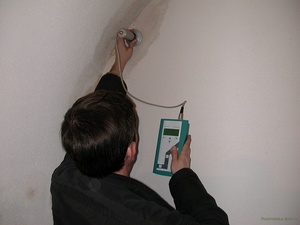
Dehumidifiers can be portable and stationary, which are mounted into the wall and have a large capacity.
An oil cooler can also be used as an air dryer. m equipped with a fan.
The kitchen and bathroom need install hoods. They will help fight moisture and excess odors.
If the humidity index is increased, then it is not recommended to dry the washed laundry in the room, and the sink and bath should be wiped immediately after use.
But, with any indicators of air humidity, it is necessary to ventilate the room as often as possible. Oxygenated fresh air kills bacteria, fungi and neutralizes dust mites. And most importantly, it normalizes the humidity in the room, while establishing a comfortable microclimate for a person, which is so important for health and well-being.
What is the humidity level in the apartment? Most people can easily answer what the temperature should be in a living space, but the question of humidity will confuse them. And only a few will be able to name the correct numbers. Meanwhile, humidity is one of the main indicators of the microclimate level in the house.
The norm of humidity in the apartment
The humidity in the room is measured by a special device - a hygrometer. They vary in design (digital, hairline, wireless) and measurement range, but each is very easy to use. In any case, no more difficult than with a conventional thermometer.
The humidity level depends on the type of room. For example, in bakeries, in fermentation rooms, in poultry houses, in cold warehouses for food storage, it is 70-80%. In greenhouses for growing tulips, it can reach 95%, and this is considered the norm. But for rooms with computers, telephone nodes and office equipment, the indicators should not exceed 50%.
The rate of humidity in the apartment also depends on the type of room. On average, the numbers fluctuate between 40-60%. According to sanitary rules, in living rooms and in the interior corridor, the optimum humidity in the cold season should be 30-45%. Permissible rates for these types of premises - up to 60%.
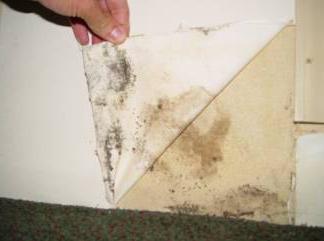
In the warm season, the optimum humidity in the apartment is 30-60%. Permissible - up to 65%. However, in regions with high air humidity (above 75% outdoors), the permissible values are increased to 75%.
In the kitchen, toilet, bathroom, lobby, on and in the pantry, this indicator is not standardized.
Various indicators and the need to use special devices - all this may seem too complicated for the average person. Therefore, in order to find out whether the humidity in the apartment is high or low, you can experiment with a glass. We take a glass or a stack (any glass vessel), pour water into it, cool it to 3-4 ° C in the refrigerator. Then you need to put the vessel in the room and observe:
- the walls of the vessel fogged up, and then dried up in 5 minutes - the humidity is lowered, the air is dry;
- after 5 minutes the walls are wet - optimal performance;
- after 5 minutes, streams run along the walls of the vessel - high humidity.
This is how you can easily find out the microclimate in the room, but for the purity of the experiment, the glass must be placed away from heating devices.

What is harmful high humidity
High humidity is foggy windows, linen drying for several days, clothes with an unpleasant moldy smell, fungi and mold. Only these factors make the house unsuitable for living. It is also worth adding that such a microclimate does not have a very good effect on human health: fungal spores during
contact with food can cause poisoning and allergies, heat exchange processes are disturbed, and the risk of infection increases. A person living in a house with high humidity gets sick more often and for longer.
How low humidity affects the human body
Low humidity also causes a number of problems. The intensity of evaporation from everything that contains water increases: from human skin, from plants. The latter dry out, and the skin loses its elasticity and ages. The nasal mucosa dries up, which means that there is a risk of a runny nose and acute respiratory infections. Respiratory organs suffer, especially in asthmatics and allergy sufferers.
The norm of humidity in an apartment is not an abstract concept. These are real numbers that allow you to understand how safe the indoor climate is. And if the air humidity is greatly reduced or increased, it is necessary to ensure that it corresponds to normal values.
Ways to reduce humidity
There are two main methods
- Find and eliminate the cause of high humidity. This can be a temporary increase in performance due to cooking, showering or drying things, lack of sunlight, lack of proper ventilation, sealed PVC windows, etc. For each reason, you can choose a way to eliminate it: make good ventilation, ventilate rooms more often, increase batteries, etc.
- Forced dehumidification with special dehumidifiers, moisture-absorbing chemicals and climate control systems.
Ideally, only the first method should be used, but if this cannot be done or is associated with serious financial costs, then the second one can be used. 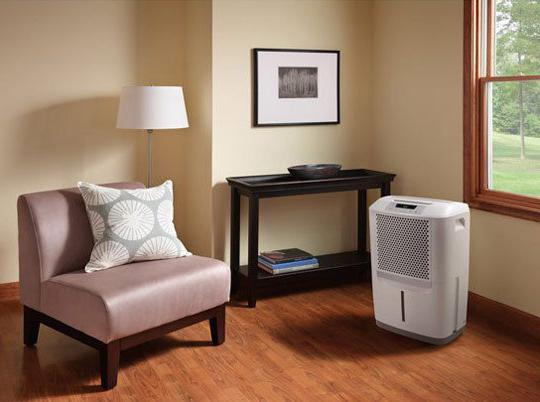
Humidity Increase Methods
Most often, dry air in the room is formed in the winter, when the heating devices are intensively working, and the rooms are criminally rarely ventilated. However, this problem can also be overcome. The norm of humidity in the apartment with dry air is achieved through the following measures:
- The presence of an aquarium in the room or
- Presence a large number plants.
- Installation of a household humidifier.
- Reducing the frequency of using any household appliances, especially heating ones.
- Frequent ventilation.
Optimum humidity in the apartment is a guarantee of your health and ensuring the right level of comfort in the house. And don't skimp on your health. Therefore, try to maintain normal humidity levels, even if by force.



